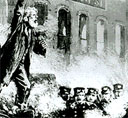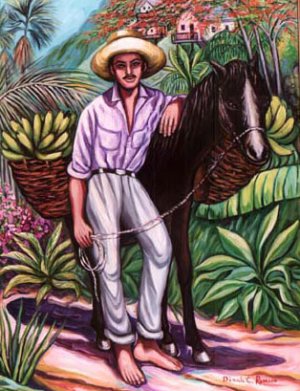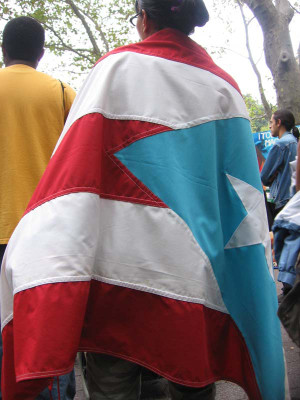History
Haiti: The Slave Army of Toussaint L’Ouverture
by Mike Ely
“When the slave revolt broke out, Toussaint was already 45–old for a slave in Haiti. He simply took over the plantation–and waited to see what would happen. After several weeks, he decided that there was a chance of something really lasting. He sent his own family into safety across the border in the Spanish colony, and rode into the surrounding rebel camps. Step by step, he set out to build a disciplined fighting force….
‘Toussaint set about forming a disciplined core and deliberately started small. He recruited a few hundred men and launched offensive actions against the advancing counterrevolutionary troops….
“Toussaint’s force fought with a conquering spirit that soared among the clouds and rainbows. When they ran out of food, they fought hungry. When they ran out of ammunition they fought with stones. When the British troops spread splintered glass on the battlefield, Toussaint’s fighters advanced on bloody, lacerated feet.”
* * * * * *
The Tulsa Massacre 1921: Mass Murder of a Black Community
by Mike Ely
On May 30, 1921, a rumor swept through the booming western oil town of Tulsa, Oklahoma that a young Black man had insulted a white woman in a downtown elevator.
According to the white supremacist rules of U.S. society, the accused man faced an immediate death sentence. Since the turn of the century, many hundreds of Black men in the U.S. had been brutally lynched and mutilated by vigilante gangs–without trial or investigation–often for accusations of “affronting white womanhood.”
But this time, in Tulsa, it was different. This time there was resistance. Organized militant forces in the Black community stepped forward to defend Dick Rowland.
All the hateful forces of white supremacy in the area responded to that resistance with two feverish days of murder and fire. The dead of Tulsa’s Black community lay stacked in piles. And the central Black business district of North Tulsa was totally burned out.
Tulsa 1921 is a story of brutal “ethnic cleansing” and genocide. This was the largest “civil disturbance” since the Civil War and the anti-Indian wars of the 1800s. It is a story that has been systematically censored by the system–despite the repeated efforts of the Black press, revolutionary forces and progressive historians to bring the facts to light.
* * * * * * * *
The Making of the Communist Manifesto
by Mike Ely
 |
|
|
In mid-February 1848, a new communist pamphlet rolled off the presses of a small printshop on London’s Bishopsgate. It was written in German and entitled Manifest der Kommunistischen Partei. Copies were rushed off to the mainland of Europe. Uprisings and disturbances had broken out in most of the main population centers of the continent. Small cores of revolutionary activists were waiting for a high-powered declaration that could guide their work and rally the masses of people to a thoroughgoing revolutionary movement.
The bold opening lines of this pamphlet threw down a challenge: “A spectre is haunting Europe–the spectre of communism. All the powers of old Europe have entered into a holy alliance to exorcise this spectre…. It is high time that Communists should openly, in the face of the whole world, publish their views, their aims, their tendencies, and meet this nursery tale of the spectre of communism with a manifesto of the party itself.”
This work was quickly translated into many languages of Europe and the Americas. In English it became known as the Communist Manifesto. In one early English version, published in 1850, the previously unknown authors were listed for the first time: Karl Marx and Frederick Engels.
* * * * * * *
 Memories for International Women’s Day: Women of the Triangle Fire
Memories for International Women’s Day: Women of the Triangle Fire
Also published by the IWW (Industrial Workers of the World) in a convenient two page newspaper format on pages 8-9 of the March 2011 issue of their Industrial Worker newspaper.
Growing up in the 1960s, I would wander with friends through New York’s Greenwich Village. Often we passed the plaque on an NYU office building that marks the site of the 1911 Triangle Fire. Then and now, it would not take much for us to imagine that narrow street piled with the smoldering bodies of women workers, or imagine their screams as they plunged down from above, trailing flames behind them. Often, in those heady days, we would swarm out of Washington Square Park, flying our red and black flags high, and take the streets of the Lower East Side. And many among us would imagine that marching alongside us were those fearless sisters of the Ten Thousand whose dreams of revolution and socialism had echoed, like ours, through the narrow streets of Alphabetland.
And now, decades later, young women all over the world are relentlessly herded in unprecedented numbers into brutal sweatshops and the global sex trade — worked without mercy, threatened, underpaid, raped, beaten, and then discarded.
This story of the Triangle Shirtwaist Factory is not a world of the past, it is the world of our present. The bitterness of this fact shatters claims of social progress over the last century. All the accumulated wealth and technology has brought us to this: we need a revolution.
Mumia Abu-Jamal: Enemy of the State
“They don’t just want my death, they want my silence.”
Mumia Abu-Jamal
On August 8, 1978, Mayor Frank Rizzo was in a combative mood at a special afternoon press conference in Philadelphia’s City Hall. Just hours before, Rizzo’s police had staged a massive raid on the home of the radical MOVE organization on Powelton Avenue. After attacking the house with intense gunfire, tear gas and a flood of water, police arrested the MOVE members and publicly beat Delbert Africa as he surrendered.
At City Hall, Rizzo was blunt with the press: he expected them to close ranks in support of police actions. Then, from the crowded pack of reporters, a young Black journalist spoke out in the resonant tones of a radio broadcaster. He raised pointed questions about the official police story Rizzo had just laid out. Mayor Rizzo exploded in fury and spat out a thinly veiled threat: “They believe what you write, and what you say, and it’s got to stop. And one day–and I hope it’s in my career–that you’re going to have to be held responsible and accountable for what you do.”
The journalist who challenged Rizzo that day was Mumia Abu-Jamal. He had spent a decade exposing the racism of Philadelphia’s police and legal system.
The Slave Rebellion of General Nat Turner
By Mike Ely
 Slaveowners in the United States always insisted that “their” slaves were content and obedient. But research has documented at least 250 revolts, both large and small, in the U.S. during slavery times. And much was done to hide their existence. James Madison, the main author of the U.S. Constitution, warned in 1774 that it was best that “such attempts should be concealed as well as suppressed.” One of the largest revolts was led by the slave Nat Turner in Southampton County, Virginia during the summer of 1831.
Slaveowners in the United States always insisted that “their” slaves were content and obedient. But research has documented at least 250 revolts, both large and small, in the U.S. during slavery times. And much was done to hide their existence. James Madison, the main author of the U.S. Constitution, warned in 1774 that it was best that “such attempts should be concealed as well as suppressed.” One of the largest revolts was led by the slave Nat Turner in Southampton County, Virginia during the summer of 1831.
Nat Turner was born on the Virginia farm of Benjamin Turner on October 2, 1800. It is said that his African-born mother so hated slavery that she wanted to kill Nat at birth rather than let him grow up in bondage.
Where’s Our Mississippi?
 By John Steele
By John Steele
In the summer of 1964, three civil rights workers were murdered in Mississippi. They are known to the world as Goodman, Chaney and Schwerner. But back then, in the days before they died, I knew them as Andy, JE, and Mickey.
I want to share with you my memories of the time we drove south together to join the Mississippi Freedom Summer project. I want to tell a bit of the story of that summer, and tell it for a purpose. I believe it has implications for today.
Driving South
Mickey was driving as we pulled out of Oxford, Ohio in his station wagon, windows down, through the lush green of early summer. The four of us were volunteers. We were excited. And we felt some fear. We were part of a project to fight white supremacy in Mississippi, where the most basic democratic rights were denied to African American people. We were going to throw ourselves into the front lines of a cause that called itself, simply, the Movement.
The Origin of May Day: Haymarket 1886 & the “Troublesome Element”
By Mike Ely
 During 1885 a circular passed hand to hand through the ranks of the proletariat in the United States. With the following words it called for class-wide action on May 1, 1886:
During 1885 a circular passed hand to hand through the ranks of the proletariat in the United States. With the following words it called for class-wide action on May 1, 1886:
“One day of revolt – not rest! A day not ordained by the bragging spokesmen of institutions holding the world of labor in bondage. A day on which labor makes its own laws and has the power to execute them! All without the consent or approval of those who oppress and rule. A day on which in tremendous force the unity of the army of toilers is arrayed against the powers that today hold sway over the destinies of the people of all nations. A day of protest against oppression and tyranny, against ignorance and war of any kind. A day on which to begin to enjoy ‘eight hours for work, eight hours for rest, eight hours for what we will.’”
I’ll Fly Away, O Glory! — Outlaws of the Underground Railroad

By Mike Ely
Throughout the early existence of the United States, slavery was legal. It was honored in the highest offices, in the nation’s pulpits, the courts, and the press. It was defended by troops, police, posses and informants — using extreme violence. And long before there were hopes that it might be ended by a civil war — there were slaves who rose up to rebel and escape. And standing with them was a radical and widely denounced movement of abolitionists who helped prepare the political ground for revolution and emancipation. This political preparation operated on several levels: The slaves, isolated on the broad southern belt of forced labor camps, fought. In the North, the abolitionists waged a fierce campaign of public agitation — denouncing slavery in pamphlets and speeches, often at great risk to their lives. And sections of this movement organized themselves to help the slaves escape — creating the Underground Railroad.
How did this armed resistance movement, and the public political defense of its illegal acts help prepare for the actual revolutionary war that abolished slavery? How does resistance give rise to revolution? What is the role of militant action and outlaw organization — in the process of preparing revolution? And how do we answer such questions today — as we seek ways to uphold our criminalized brothers and sisters among the immigrants or among black youth, or the deserters from the army, or the members of other despised and persecuted sections of society. What can we learn from the Santuary movement of the 1980s? Or the draft resistance movement of the 1960s? Or the illegal strike movements of the coalfields? Or the many other places where the desperate lives and bold actions of people defied the way things are — even before their understanding imagined another way things could be.
Puerto Rico’s Fight for Independence
July 25, 1898–thousands of U.S. troops invaded Puerto Rico’s southern coast from the sea–landing at the small port of Guánica and then in the larger town of Ponce. A force of 16,000 moved onto the island, commanded by U.S. General Nelson A. Miles. In Puerto Rico, African slaves, Native peoples and Spanish immigrants had already forged a unique people and rich culture during 400 years of Spanish colonial rule. A million people lived on the island, mainly scattered in small villages, fishing and farming to gather the food they needed. These Puerto Rican people had long fought their oppressors.
The Taino Indian people had fought from the beginning–in the face of genocidal policies that drove them into the highlands and left few of them alive. The captive Africans had risen up in repeated uprisings against their enslavement. And, in 1868, the independent Republic of Puerto Rico was first proclaimed in the famous armed uprising against Spain — El Grito de Lares, the Cry of Lares.
The U.S. high command had chosen to land their troops on the island’s southern coast because the people were known for their resistance to the central colonial authorities. When the U.S. troops landed, many Puerto Rican people welcomed them. Everyone knew that the U.S. had also once been a colony. And they believed that its armed forces had come to end Spanish oppression. In towns like Ciales, Adjuntas, Yauco, and Mayaguez, Puerto Rican guerillero bands took up arms against the Spanish. But when a treaty was finally signed on December 10, 1898 in Paris, passing the Spanish colonies of Puerto Rico, Guam, and the Philippines to U.S. control, the people of those countries were not consulted or involved. Their local governing bodies were ignored.
The State Persecution of Puerto Rican Independentistas
In 1979, the U.S. government finally freed the Puerto Rican prisoner Lolita Lebron from Alderson’s Federal Women Prison in West Virginia. As news of her impending release reached us, revolutionaries across that state piled into our cars. As the dawn broke we found a open spot along that lonely country road where she would be driven as she left the high gray prison walls. We held high our brilliant red flags and held out our small children to greet this sister as she rolled past. It was a beautiful morning.
A memory from the Wall of the Communards
 by Mike Ely
by Mike Ely
It was a rainy morning. But it was the only day I had in the city and I wanted to pay my respects.
My walk took me slowly up the streets of Belleville, the old working class district on the eastern edge of Paris. The neighborhood was still poor. Sidewalks and cafes were full of Arab and African immigrants. The cops appeared only in groups, heavily armed.
And so it was not hard to go back to 1871 in my mind, and imagine the fighting, up those narrow streets. The skies had been lit by flames and heavy with smoke as the Communards retreated before troops, block by block, in fierce fighting, until the last of revolutionary fighters were cornered in Pere Lachaise cemetery.
Evaluating the Cultural Revolution in China and its Legacy for the Future
 By the Marxist-Leninist-Maoist Revolutionary Study Group in the U.S.
By the Marxist-Leninist-Maoist Revolutionary Study Group in the U.S.
It describes the course of the Cultural Revolution from 1966-1976, its achievements and shortcomings, and argues that future movements for revolution, socialism and communism must stand on its shoulders.
Part 1: Seeding Machine for Revolution
Part 2: The Sweep of A Revolution, 1966-1976
Part 3: A Startling Theoretical Leap
Part 4: Radical Changes in Culture
Part 5: Deep Among the People
Part 6: The Winding Road
Part 7: Struggling to Liberate Women
Part 8: Conceptualizing Socialist Society
Part 9: Summing Up the Revolution
Available as Word doc: Evaluating the Cultural Revolution in China and its Legacy for the Future.
Kasama will soon post a printable pdf version as part of Kasama’s Documents for Discussion pamphlet series.
Sale of Budweiser: Memories of Beer Lovers, Hemp Farmers & Bloody Revolution
By Mike Ely
Ok, I admit it. I’m not your usual observer. When I heard that Budweiser had been bought by the Euro-capitalists InBev, I was not concerned. I don’t care who owns the factories in the U.S. I don’t worry the U.S. heartland is being infiltrated by foreign interests. And certainly, I don’t consider Budweiser a national treasure. The truth is that it’s almost undrinkable.
But my ears perked up when I read how Budweiser’s maker, Anheuser-Busch had roots in St. Louis that went back before the Civil War. Ah, my friends, THERE is a story worth telling. And I’m going to sit back in the damp heat of this Chicago evening, sip on a couple of Fat Tires, and tell it to you, just because I hate patriotic bullshit and because I love revolution.
First, there is nothing American about beer making in St. Louis.
St. Louis in the 1850s was a raw river town situated where the Missouri River and the broad Mississippi met. It was a frontier town in many ways and the jumping off point. It was the “end of the line” for civilization. But it was also one of the first American industrial cities, with one of the heaviest concentration of of factory workers in the country. And these workers were not native-born Americans.
Blacks and Jews: A Revolutionary View
By Mike Ely
 Some people argue that Jewish people have played a special role throughout history–oppressing Black people and keeping them from achieving prosperity within the capitalist system.
Some people argue that Jewish people have played a special role throughout history–oppressing Black people and keeping them from achieving prosperity within the capitalist system.
It is argued that Jewish merchants and slaveowners played a special role in the brutal slave trade that brought kidnapped Africans to the New World.
It is said that Jewish merchants and landlords are a special cause of the poverty of Black communities.
It is said that “Jewish control” of the media and educational institutions has led to a conscious “Jewish conspiracy” to produce “negative images” and “self-hatred” among Black people.
These views are not true…
Native Blood: The Myth of Thanksgiving
by Mike Ely
 It is a deep thing that people still celebrate the survival of the early colonists at Plymouth — by giving thanks to the Christian God who supposedly protected and championed the European invasion. The real meaning of all that, then and now, needs to be continually excavated. The myths and lies that surround the past are constantly draped over the horrors and tortures of our present. I originally wrote this article a decade ago, and it has showed up in different places and publications usually around the holiday. Pass it on.
It is a deep thing that people still celebrate the survival of the early colonists at Plymouth — by giving thanks to the Christian God who supposedly protected and championed the European invasion. The real meaning of all that, then and now, needs to be continually excavated. The myths and lies that surround the past are constantly draped over the horrors and tortures of our present. I originally wrote this article a decade ago, and it has showed up in different places and publications usually around the holiday. Pass it on.
Every schoolchild in the U.S. has been taught that the Pilgrims of the Plymouth Colony invited the local Indians to a major harvest feast after surviving their first bitter year in New England. But the real history of Thanksgiving is a story of the murder of indigenous people and the theft of their land by European colonialists–and of the ruthless ways of capitalism.
The Last Day of Lightening Lane
 By Mike Ely
By Mike Ely
Lightning Lane was one of the only Black foremen at the mine. And in the 1970s that was rare for the whole industry.
For decades there had been sharp divisions within those few mines that even hired Black men, like U.S Steel Gary Holler, Eastern Associated’s Keystone #1 or Consol’s Eckmann.
The Black workers made less money, and in a crudely racist fashion they were considered unfit for the skilled jobs or foremen’s positions. Black workers at my mine largely worked as motormen, running the long chains of coal cars out of the mine to the tipple, outside where the coal was dumped onto the railroad. And white workers largely worked at the face of the mine — deep in the tunnels where the coal was clawed out and loaded onto conveyor belts. And all the most privileged jobs — like setting up water pumps, or maintaining the air fans, or machining replacement parts for the worn equipment were the reserve of white workers who guarded their skills jealously.
And so it was, undoubtedly, the breaking of a barrier for Lightning Lane to make his foreman’s papers and be put in charge of a crew of men. And it was undoubtedly the breaking of a barrier for those white guys to take their orders from a Black man — especially who was not given to polite talk and deference. And in those days many such barriers were being broken, and such divisions were breaking down. And today, I guess, in the aftershock of Obama’s victory, we are all reminded how much the breaking of these barriers have meant to Black people in the long climb out of slavery.
But for all that, I have to add that Lightning Lane was a royal asshole. I mean really.
The Maoist Revolution in Tibet
By Mike Ely
Tibet is one place where “common knowledge” clashes sharply with facts and reality.
Pre-revolutionary Tibetan society is wildly romanticized, so that many people have very little sense of the brutality of life and the horrific backwardness enforced by the Lamaist theocracy of monks. Based on such a myth, the arrival of revolutionary forces can be portrayed as a foreign invasion. And, thanks to the propaganda of exiled monks, the following decades of socialism are portrayed quite literally as a genocide.
History’s facts are very different…
 Slipping Into Darkness: The Last Revolutionary Years of the Comunist Party USA (1929-1935)
Slipping Into Darkness: The Last Revolutionary Years of the Comunist Party USA (1929-1935)
By Mike Ely
This analysis examines the period considered by some the “good years” (i.e. the revolutionary period) of the Communist Party of the U.S. The piece was originally written in 1980 right after I had left the coalfi elds. It was based on research into this history but also our own experience of trying to develop revolutionary organization among workers using a left-economist approach. As I re-read this piece, after so many years, there were inevitably new questions that came to mind — but I won’t get into them here. I just want to off er it online because it think it raises important questions about how revolutionary organizations respond to a major economic crisis, how revolutionary consciousness developes among the oppressed and because it speaks to issues around trade union organizing that have re-emerged among a new generation of revolutionaries. I look forward to correspondence and discussion with any of you who would like to explore these historical and political questions together.












Mike Ely @ Kasama: The Thanksgiving Story « The China Rose said
[…] as podcast. More history posted […]
Alchemy of Light » Blog Archive » Native Blood: The Myth of Thanksgiving by Mike E said
[…] as podcast. More history posted […]
National Students federation (NSF) India said
NATIONAL STUDENTS FEDERATION (NSF) INDIA
NATIONAL STUDENTS FEDERATION(NSF)INDIA IS A REVOLUTIONARY STUDENTS ORGANISATION. NSF LAUNCHED IN 1990 IN AMRITSAR CITY, THE STATE OF PUNJAB IN INDIA. REVOLUTIONARY STUDENTS OF AISSF,NSUI,SFI AND PSU ADOPED NEW REVOLUTIONARY LINE OF INDIAN NATIONALISM. WE SUPORTS LEFT AND NATIONALIST DEMOCRATIC AND REVOLUTIONAY FORCES. WE THINK INDIA IS A PEOPLES DEMOCRATIC STATE. ONE DAY POLITICAL POWER OF INDIA WILL BE IN THE HANDS OF STUDENTS . WE THINK INDIA IS ONE COUNTRY FROM SHRI LANKA TO AFGANISTAN. LETS JOIN HANDS FOR PEOPLES REVOLUTION IN INDIA. ALL LEFT, DEMOCRATIC,LEFT REVOLUTIONARY,REVOLUTIONARY NATIONALIST, SOCIAL AND SOCIAL REVOLUTIONARY FORCES TO JOIN HANDS AT COMMOMN MINIMUM PROG. WE ARE LAUNCHING NSF AS A POLITICAL PARTY OF NATIOANLIST AND SOCAIL REVOLUTIONARY INDIANS. LETS START DISCUSSION FOR REVOLUTION IN INDIA.LETS FIGHT FOR THE INDIAN NATIONALISM AND SAVE INDIAN REVOLUTIONATY HISTORY AND RIGHTS OF PEOPLES .
Students are a dynamic part of every society that reacts to every in-justice and exploitation in the society.Looking at this vital note of students, different political parties have formed their student wing so that they can use students as a fuel for achieving their own agenda. This way, they want that students should get away from the path of actual struggle for “students rights and public right” and that students may become a part
email- nsf@indiamail.com
> JOIN NSF INDIA
TO BUILD INDIA WORLD POWER
> STUDY AND STRUGGLE IS OUR AIM
> GET KNOWLEDGE AND FIGHT FOR RIGHTS
> INDIA IS ONE COUNTRY FROM SHRI LANKA TO AFGHANISTAN
Red Fly said
Link to “Slipping into Darkness” is broken.
Native Blood: The Myth of Thanksgiving « Kasama said
[…] History […]
The Original Occupation: Native Blood & the Myth of Thanksgiving | Unsettling America said
[…] This piece is available as podcast. It is part of our larger Kasama offerings on peoples’ history. […]
Ric Frye said
The link to “Slipping into Darkness” is STILL broken after over a year after it was reported the first time.
onehundredflowers said
Fixed